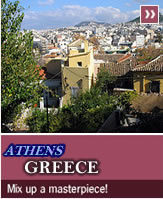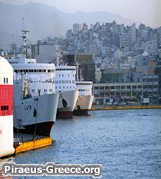













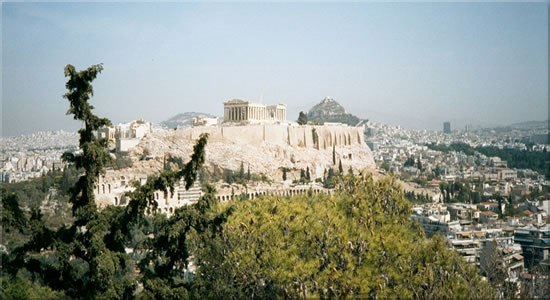
ancient olympia video
ancient greece map
olympia satellite view
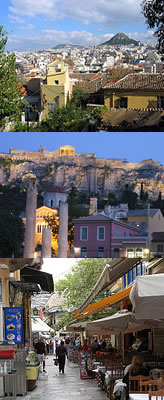
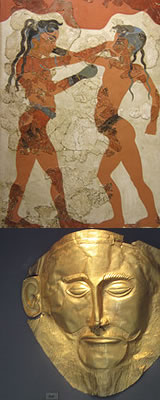
Athens National Museum
Athens is simultaneously know as the classical, marble pillared cradle of western civiization and as a modern urban sprawl of concrete and traffic.
History :: Athina is named after Athena, the goddess of wisdom, who, according to legend, won the city after defeating Poseidon in a duel. The goddess’ victory was celebrated by the construction of a temple onthe Acropolis, thesite of the city’s earliest settlement in Attica. As a city state, the coastal capital of Athens reached its heyday in the fifthcentury BC. The office of the statesman, Pericles, between 461BC and his death in 429BC, saw an unprecedented spate of construction resulting in many of the great classical buildings(the Parthenon, Erechtheion, Hephaisteion and thetemple at Sounion) now regarded as icons of ancient Greece
Physical evidence of the city’s success was matched by achievements in the intellectual arts. Democracy was born, drama flourished and Socrates conceived the foundations of Western philosophy. Remarkably, although the cultural legacy of this period has influenced Western civilization ever since, the classical age in Athens only lasted for five decades. Under the Macedonians and Romans, the city retained a privileged cultural and political position but became a prestigious backwater of the Empire rather than a major player. The birth of Christianity heralded a long period of occupation and decline, culminating in 1456 and four centuries of Turkish domination, which has left an indelible cultural mark on the city. By the end of the 18th century, Athens was also suffering the indignity of having the artistic achievements of its classical past removed by looting collectors.
Modern Athens was born in 1834, when the city was restored as the capital of a newly independent Greece. Greek refugees flooded the city at the end of the Greek-Turkish war, swelling the population. After World War II, American money funded a massive expansion and industrialization program. The rapid growth of the post-war years and the high temperatures of its Mediterranean climate have created a city that can often be polluted and could be described as an urban sprawl. Excessive traffic creates a gridlock on the streets and noxious fumes (nefos) in the air, although great efforts are being made to reduce this. Visitors with visions of gleaming marble and philosophers in white robes are understandably perturbed that the architectural achievements of Athens’ classical past are surrounded by the unforgiving concrete of indiscriminate 20th-century urbanization. Over three million visitors come to the city each year but the majority see the sights as quickly as possible (as if fulfilling some cultural duty) before heading off for the easy hedonism of the Greek islands.
However, Athens repays a closer acquaintance. In addition to the celebrated classical sites, the city boasts Byzantine, medieval and 19th-century monuments, as well as one of the best museums in the world and areas of surprising natural beauty. Despite the traffic, an appealing village-like quality becomes evident in the cafes, tavernas, markets and the maze of streets around the Plaka. Moreover, Athens has the finest restaurants and the most varied nightlife in the country and remains a major European center of culture, celebrated each year at the Athens Festival. The metropolitan area, including the port at Piraeus, is the indisputable industrial and economic powerhouse of the country, while the return of the Olympic Games in 2004 is prompting a flurry of new development. Major projects include the new Eleftherios Venizelos International Athens Airport, the extension of the Athens metro system, the building of new sports venues, the upgrading of hotel accommodation and the revitalization of the Piraeus port area. The world-renowned National Archaeological Museum, which was closed for renovation through 2003, is due to reopen for the Olympics, although the long-awaited New Acropolis Museum has fallen way behind schedule. In addition, ancient sites within the city center are being linked by a traffic-free ‘archaeological promenade’ intended to enhance the urban environment for locals and visitors alike.
The return of the Olympic Games in 2004 prompted a flurry of development, including a new airport, the extension of the metro system, the building of new sports venues, the upgrading of hotels, the renovation of several top museums, and the formation of a traffic-free ‘archaeological promenade’.
Top Attractions
Acropolis
If you’re only in Athens for a day, this is the one sight to see. The temples, especially the great Parthenon, built to honour Athena, have been the dominating influence in Western architecture for over 2,000 years.
Kallimarmaro Stadium
The formal name of this stadium is the Panathenaic, but it’s more commonly known as Kallimarmaro, meaning “beautiful marble”. Built in 330 BC for the Panathenaic games, it later fell into disuse. In 1895, George Averoff had it restored with fine Pentelic marble, and it hosted the first modern Olympics in 1896. In 2004, it provided the final circuit for the Olympic Marathon and also hosted the archery competition
National Gardens
The huge, shady National Gardens are an unexpected green refuge in parched central Athens. They were originally planted in 1839 as the Royal Garden of Queen Amalia, who had her horticulturalists bring in 15,000 domestic and exotic plants, many of which remain. The garden was opened to the public in 1923. Many statues dot the garden. It also has a small zoo, a duck pond and a playground.
Evzones
On guard in front of Parliament are the famous evzones , soldiers in the traditional attire of the rebels who won the War of Independence. It’s hard to imagine fighting efficiently in this uniform: a short white skirt (with 400 pleats, symbolizing the years under Turkish rule), red cap, and red pompommed shoes. The changing of the guard is like a slow high-kick dance. Evzones are selected from the tallest and handsomest men in the mandatory Greek military service.
Athens Accommodation
In Athens and the greater Athens area (including the suburbs, Pireaus and Attica), are more than 700 lodgings of all categories, with a total capacity of about 66,000 beds. Most of the lodgings have been renovated and modernised recently and have high quality, modern facilities.
History :: Athina is named after Athena, the goddess of wisdom, who, according to legend, won the city after defeating Poseidon in a duel. The goddess’ victory was celebrated by the construction of a temple onthe Acropolis, thesite of the city’s earliest settlement in Attica. As a city state, the coastal capital of Athens reached its heyday in the fifthcentury BC. The office of the statesman, Pericles, between 461BC and his death in 429BC, saw an unprecedented spate of construction resulting in many of the great classical buildings(the Parthenon, Erechtheion, Hephaisteion and thetemple at Sounion) now regarded as icons of ancient Greece
Physical evidence of the city’s success was matched by achievements in the intellectual arts. Democracy was born, drama flourished and Socrates conceived the foundations of Western philosophy. Remarkably, although the cultural legacy of this period has influenced Western civilization ever since, the classical age in Athens only lasted for five decades. Under the Macedonians and Romans, the city retained a privileged cultural and political position but became a prestigious backwater of the Empire rather than a major player. The birth of Christianity heralded a long period of occupation and decline, culminating in 1456 and four centuries of Turkish domination, which has left an indelible cultural mark on the city. By the end of the 18th century, Athens was also suffering the indignity of having the artistic achievements of its classical past removed by looting collectors.
Modern Athens was born in 1834, when the city was restored as the capital of a newly independent Greece. Greek refugees flooded the city at the end of the Greek-Turkish war, swelling the population. After World War II, American money funded a massive expansion and industrialization program. The rapid growth of the post-war years and the high temperatures of its Mediterranean climate have created a city that can often be polluted and could be described as an urban sprawl. Excessive traffic creates a gridlock on the streets and noxious fumes (nefos) in the air, although great efforts are being made to reduce this. Visitors with visions of gleaming marble and philosophers in white robes are understandably perturbed that the architectural achievements of Athens’ classical past are surrounded by the unforgiving concrete of indiscriminate 20th-century urbanization. Over three million visitors come to the city each year but the majority see the sights as quickly as possible (as if fulfilling some cultural duty) before heading off for the easy hedonism of the Greek islands.
However, Athens repays a closer acquaintance. In addition to the celebrated classical sites, the city boasts Byzantine, medieval and 19th-century monuments, as well as one of the best museums in the world and areas of surprising natural beauty. Despite the traffic, an appealing village-like quality becomes evident in the cafes, tavernas, markets and the maze of streets around the Plaka. Moreover, Athens has the finest restaurants and the most varied nightlife in the country and remains a major European center of culture, celebrated each year at the Athens Festival. The metropolitan area, including the port at Piraeus, is the indisputable industrial and economic powerhouse of the country, while the return of the Olympic Games in 2004 is prompting a flurry of new development. Major projects include the new Eleftherios Venizelos International Athens Airport, the extension of the Athens metro system, the building of new sports venues, the upgrading of hotel accommodation and the revitalization of the Piraeus port area. The world-renowned National Archaeological Museum, which was closed for renovation through 2003, is due to reopen for the Olympics, although the long-awaited New Acropolis Museum has fallen way behind schedule. In addition, ancient sites within the city center are being linked by a traffic-free ‘archaeological promenade’ intended to enhance the urban environment for locals and visitors alike.
The return of the Olympic Games in 2004 prompted a flurry of development, including a new airport, the extension of the metro system, the building of new sports venues, the upgrading of hotels, the renovation of several top museums, and the formation of a traffic-free ‘archaeological promenade’.
Top Attractions
Acropolis
If you’re only in Athens for a day, this is the one sight to see. The temples, especially the great Parthenon, built to honour Athena, have been the dominating influence in Western architecture for over 2,000 years.
Kallimarmaro Stadium
The formal name of this stadium is the Panathenaic, but it’s more commonly known as Kallimarmaro, meaning “beautiful marble”. Built in 330 BC for the Panathenaic games, it later fell into disuse. In 1895, George Averoff had it restored with fine Pentelic marble, and it hosted the first modern Olympics in 1896. In 2004, it provided the final circuit for the Olympic Marathon and also hosted the archery competition
National Gardens
The huge, shady National Gardens are an unexpected green refuge in parched central Athens. They were originally planted in 1839 as the Royal Garden of Queen Amalia, who had her horticulturalists bring in 15,000 domestic and exotic plants, many of which remain. The garden was opened to the public in 1923. Many statues dot the garden. It also has a small zoo, a duck pond and a playground.
Evzones
On guard in front of Parliament are the famous evzones , soldiers in the traditional attire of the rebels who won the War of Independence. It’s hard to imagine fighting efficiently in this uniform: a short white skirt (with 400 pleats, symbolizing the years under Turkish rule), red cap, and red pompommed shoes. The changing of the guard is like a slow high-kick dance. Evzones are selected from the tallest and handsomest men in the mandatory Greek military service.
Athens Accommodation
In Athens and the greater Athens area (including the suburbs, Pireaus and Attica), are more than 700 lodgings of all categories, with a total capacity of about 66,000 beds. Most of the lodgings have been renovated and modernised recently and have high quality, modern facilities.
Inside Athens
Athens has a large selection of leisure venues to choose from, visitors will find entertainment suitable for every taste and preference.
The personality of Athens city is one of a mixture of Eastern and Western cultures, and a fusion of modern and ancient structures. Monastiraki is the old oriental bazaar located in the center of Athens below the Parthenon. In contrast, visitors can also see the many renovated neoclassic buildings scattered on the main streets in the center of town.
An excellent example of the union of old and new is the National Bank of Greece near Kotzia Square and the Athens Stock Market. The former is an ultra-modern structure built over an archaeological site, which can be seen through the bank\'s glass floors. It is quite a unique and impressive site, indicative of the desire of the Greeks to preserve the past while enthusiastically proceeding into the future.
Athenians are one of the most hospitable and helpful people, who are always eager to advise and assist visitors from abroad. They possess a wonderful zest for life and are very enthusiastic when discussing current news topics and philosophical ideas.
Travel info
Athens website
athens airport taxi
Athens has a large selection of leisure venues to choose from, visitors will find entertainment suitable for every taste and preference.
The personality of Athens city is one of a mixture of Eastern and Western cultures, and a fusion of modern and ancient structures. Monastiraki is the old oriental bazaar located in the center of Athens below the Parthenon. In contrast, visitors can also see the many renovated neoclassic buildings scattered on the main streets in the center of town.
An excellent example of the union of old and new is the National Bank of Greece near Kotzia Square and the Athens Stock Market. The former is an ultra-modern structure built over an archaeological site, which can be seen through the bank\'s glass floors. It is quite a unique and impressive site, indicative of the desire of the Greeks to preserve the past while enthusiastically proceeding into the future.
Athenians are one of the most hospitable and helpful people, who are always eager to advise and assist visitors from abroad. They possess a wonderful zest for life and are very enthusiastic when discussing current news topics and philosophical ideas.
Travel info
Athens website
athens airport taxi
Top Exhibits
Thira Frescoes
The highly advanced settlement of Akrotiri, on the island of Thira (Santorini), was buried under a volcanic eruption in the 16th century BC. Beautiful frescoes, such as these boxer boys, were perfectly preserved under the ash
Mycenaean Collection
The Mycenaeans were famed both for their prowess as warriors and their hoards of gold. Parts of those shining hoards are displayed here, including this legendary death mask and priceless golden swords.
Hellenistic Statuary
Here the stiff, solid monuments of the Archaic period give way to sculptures that are full of vigorous movement and sensuality. This is especially so in the 100 BC group of Aphrodite, Pan and Eros, the statue of a wounded Gaul and this youth of Antikythira.
Bronze Collection
Many of the greatest Archaic and Classical works were bronze, but few remain – most were melted down for weapons during invasions. This, the richest collection of the survivors, includes a majestic 460 BC sculpture of Poseidon or Zeus and this 140 BC sculpture of a galloping horse.
Classical Statuary
Collected here are original marble sculptures from temples all around Greece. Highlights are those that adorned the Asklepion at Epidauros, and works like the 100 BC Diadoumenos and a marble copy of a 5th-century bronze by the great sculptor Polykleitos
Thira Frescoes
The highly advanced settlement of Akrotiri, on the island of Thira (Santorini), was buried under a volcanic eruption in the 16th century BC. Beautiful frescoes, such as these boxer boys, were perfectly preserved under the ash
Mycenaean Collection
The Mycenaeans were famed both for their prowess as warriors and their hoards of gold. Parts of those shining hoards are displayed here, including this legendary death mask and priceless golden swords.
Hellenistic Statuary
Here the stiff, solid monuments of the Archaic period give way to sculptures that are full of vigorous movement and sensuality. This is especially so in the 100 BC group of Aphrodite, Pan and Eros, the statue of a wounded Gaul and this youth of Antikythira.
Bronze Collection
Many of the greatest Archaic and Classical works were bronze, but few remain – most were melted down for weapons during invasions. This, the richest collection of the survivors, includes a majestic 460 BC sculpture of Poseidon or Zeus and this 140 BC sculpture of a galloping horse.
Classical Statuary
Collected here are original marble sculptures from temples all around Greece. Highlights are those that adorned the Asklepion at Epidauros, and works like the 100 BC Diadoumenos and a marble copy of a 5th-century bronze by the great sculptor Polykleitos
